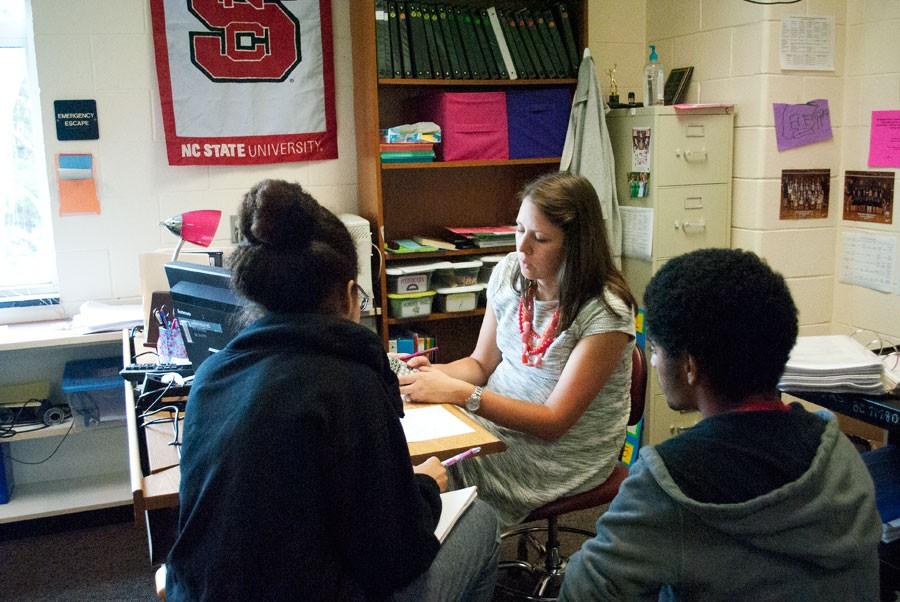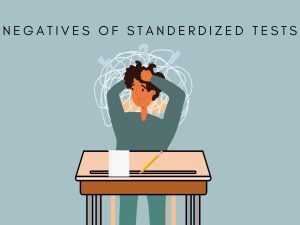Saving SMART Lunch
Mrs. Walters helps students utilize smart lunch.
October 5, 2015
For the past five years, one of Wakefield’s most popular aspects has been SMART Lunch. SMART Lunch is a fifty five minute period in between third and fourth period where students can get extra help in class by making up work and tests. Others can socialize around the school, or go off campus for lunch if the student is a junior or a senior with the proper paperwork on file. Wakefield students love to take advantage of these opportunities, but sometimes not in the appropriate way. There has been discussion of taking away SMART Lunch if students continue to misbehave and not follow the Wakefield way.
“I think smart lunch is wonderful,” said Principal Malik Bazzell. “It is a great opportunity to participate in extracurriculars during the day and to get extra tutorial, especially if you have to work after school or you are involved in track or athletics, etc. All of that is great, but we have to utilize it and the problem is that we’re not.”
Students cherish SMART Lunch to help them in their classes.
“SMART Lunch is essential to Wakefield’s core,” said senior Amelia Davidson. “You don’t have Wakefield without SMART Lunch. If it was taken away, it would do nothing but hurt the student population. Meetings and other events will get pushed until after school, which prevents those involved with sports or jobs from participating. Those not as involved will still be hurt from a lack of time spent decompressing from classes. You can’t have a machine work properly without the necessary care, and this is the same for the student brain.”
Since the main campus holds around 2,000 students and only seniors and juniors are given the privilege to go off campus, this leaves about 1,100 students on campus during lunch everyday.
“The major issue is supervision,” said Bazzell. “You can’t really control 1,100 kids because if something happens, a lot of times that mob mentality kicks in where everybody is either running somewhere to see what it is or they are trying to run away from it. The problem is more the mob because that can cause a problem more severe than the actual event that is taking place. If we can get 300-400 people to attend tutorials then we will be fine because that would alleviate the supervision problems. Right now what we’re doing is just trying to look at ways in which we can restructure SMART Lunch in order to force, in some instances, 300-400 people to go.”
The main goal of SMART Lunch is to allow students to get the extra help that they need. Administrators have given students all of this freedom for lunch in hopes that they will use it wisely.
“SMART Lunch is the best thing for the students in terms of the ability to get extra help during the school day,” said Assistant Principal Eric Betheil. “We have built fifty-five minutes in during the school day where students don’t have to worry about staying after school to make up a test, get extra help, or finish homework. If students are using it how it should be used, it can help them quite a bit in terms of passing classes.”
Teachers are very generous with their time during SMART Lunch; they will almost always be spending lunch in their classrooms ready to help any student that needs it. There are also a few teachers that will allow students to just relax in their classrooms and enjoy their lunch.
“There’s an educational and a social side to SMART Lunch,” said math teacher Rich Krassy. “The educational side indicates who needs extra help. If they come to SMART Lunch, I hope to provide them with the extra help that they need in order to get better at whatever they are looking to get better at. I also think, on the social end of it, some kids just need a place to be and if in my classroom they can do school work or have their lunch or just have a place to relax, that’s a good thing too.”
With a seven hour day, students need a break in between work to relax their brains.
“SMART Lunch is beneficial in every way possible,” said Davidson. “It essentially is a time of freedom for the students. Since students in high school will soon be on their own – and with substantially more free time – it is great opportunity for students to learn how to handle this privilege. I go on milkshake runs with my friends to decompress after a stressful course-load, I host and participate in officer meetings to make sure our group functions properly while not wasting our members’ time, I study for future tests and meet with groups about projects, I tutor fellow students who are struggling to understand class concepts, and I use the time to speak with teachers about current classwork or if there’s anything I can help with. The best part is, I’m not the only one that does this. Countless Wakefield students use this time to accomplish amazing things and I am thankful we have such a time. SMART Lunch really has brought Wakefield to the level it is today and I can’t imagine Wakefield without it.”
With this freedom comes the responsibility of using the time the right way. SMART Lunch can only help the students that choose to let it help them.
“Whenever kids do come there is always a positive effect on their grades,” said Krassy. “It is more of an effort for me to get the kids that I truly want to see in smart lunch to show up. The more regular ones are the kids looking to go from a “B” to an “A”, as opposed to the kids that are really struggling who are more of an effort to show up. It is beneficial for everybody who does it, I just would like to see more people doing it.”
As long as students use SMART Lunch in the correct way, administrators won’t have to think about taking it away.
“If [students] are doing the things that [they] need to do we are going to keep SMART Lunch in place,” said Betheil. “If things aren’t happening the way they should be, like kids are getting into fights or not going to tutorials, we will look at other avenues to get kids the extra help they need. We are not looking to take SMART Lunch away, it is in the students’ hands.”









